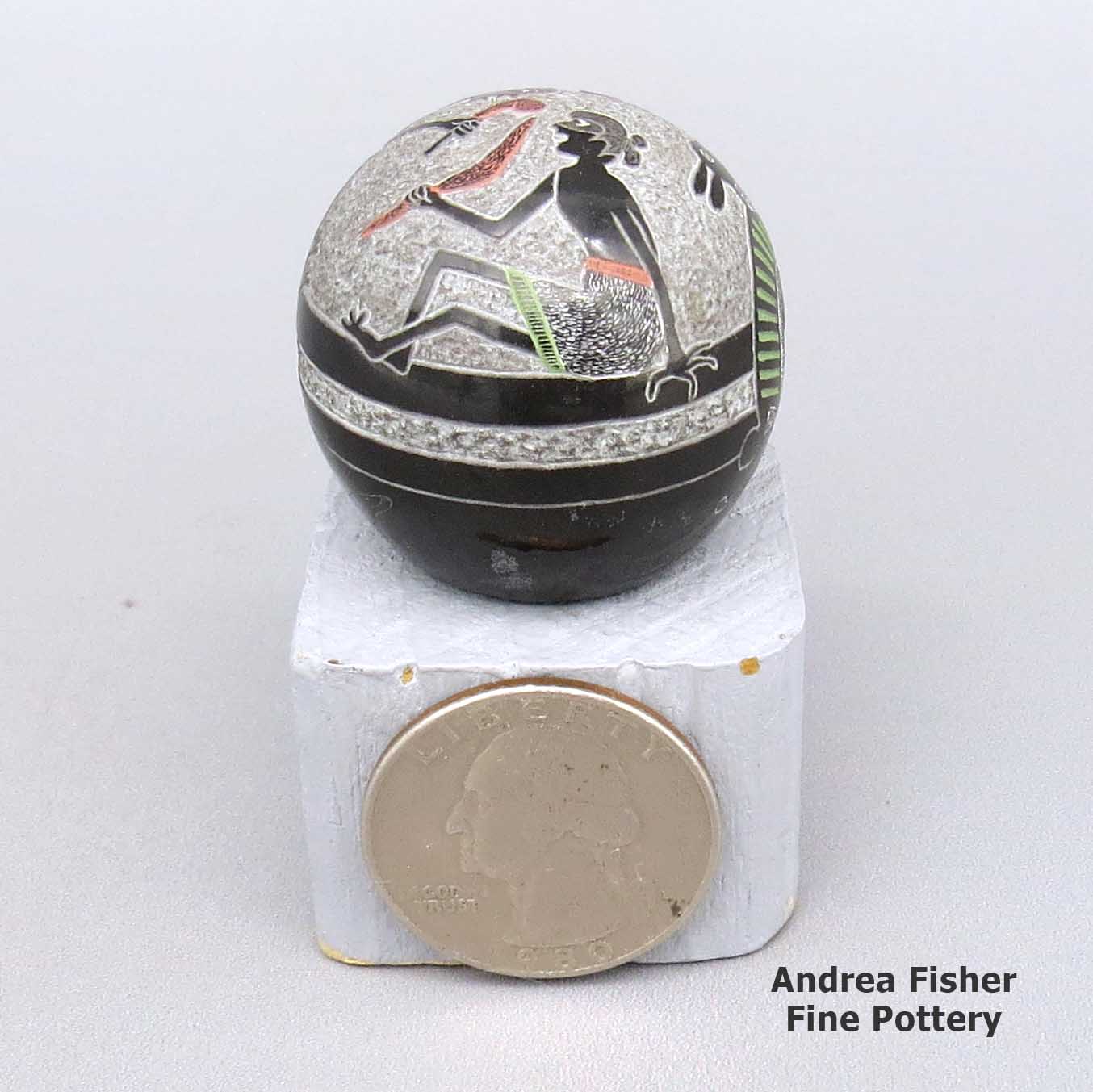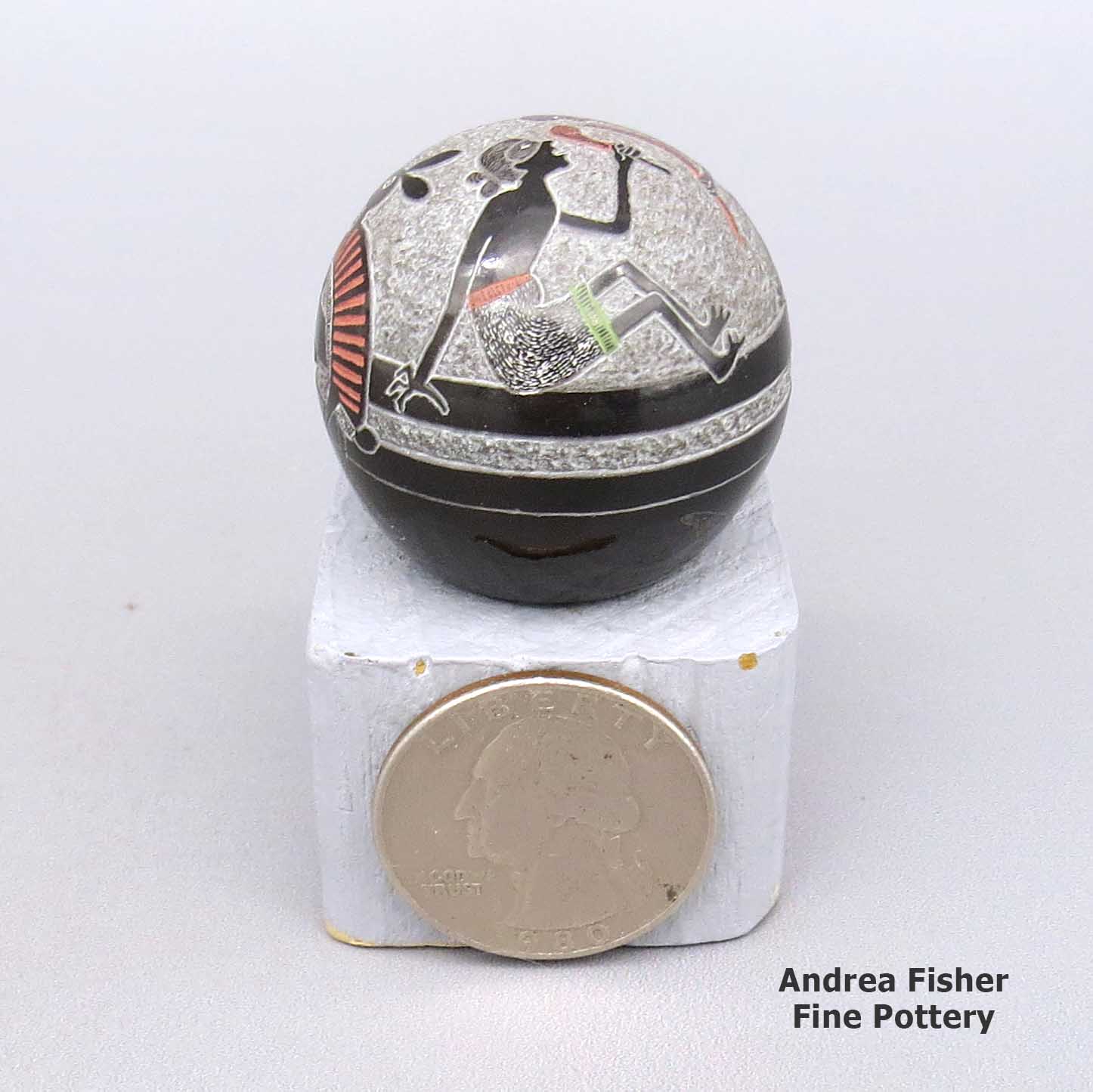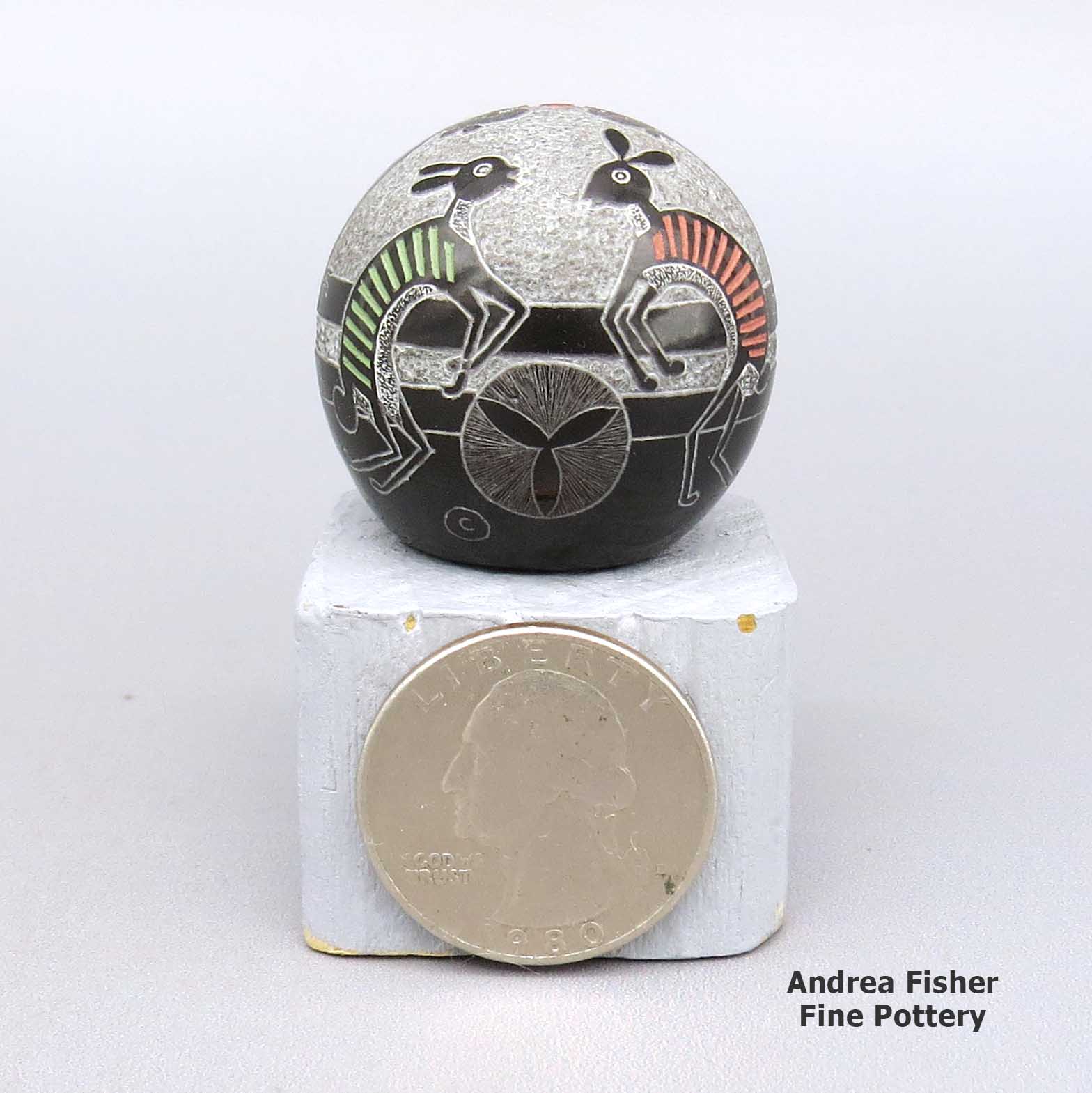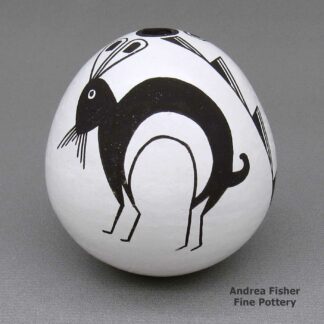| Dimensions | 1.25 × 1.25 × 1.25 in |
|---|---|
| Measurement | Stand is shown for scale only |
| Condition of Piece | Very good |
| Signature | Joseph Lonewolf B10MBCM, with wolf hallmark |
Joseph Lonewolf, zzsc2k018: Miniature polychrome seed pot with sgraffito design
$1,650.00
A miniature polychrome seed pot with a sgraffito-and-painted Mimbres rabbit, human, butterfly and geometric design
In stock
Brand
Lonewolf, Joseph
Joseph's mother taught him how to work with clay at an early age. Then his father taught him how to sculpt the clay. From his earliest years Joseph made miniature incised pots and gave them to his friends and family.
Joseph spent a number of years working as a mechanic and precision machinist in Colorado. Then in 1971 he got hurt on the job and had to return to Santa Clara. He was encouraged to become a potter by his sister, Grace Medicine Flower. He worked some with his father before dedicating himself to mastering the art. Soon he was producing exquisite, finely incised miniature pots.
Joseph's pottery has been referred to as "pottery jewels," owing to their very delicate cameo-like appearance. In 1974 a book was published entitled The Pottery Jewels of Joseph Lonewolf, one of the first books ever printed highlighting a single Native American artist.
Joseph has also been credited as the innovator of two-tone pottery (red and black) using a single-fire process. Previous methods of producing two-tone pottery required two firings.
Joseph also pioneered the use of different colored slips on his pottery, often using red, yellow, orange, green, sienna, purple, black, brown and buff slips he discovered in the soils of Colorado. His wife Kathy once said that when Joseph was riding in the car (she always drove), he could not only tell what color the passing dirt could produce when fired but he could do it at 30 miles per hour.
He always made his pots using the traditional Santa Clara techniques of hand-coiling, natural clay paints and ground-firing.
Joseph's designs were all one of a kind, incorporating elements of nature, ancient Mimbres designs and contemporary Santa Clara styles. After firing, he inspected all his pots carefully before adding his name, his wolf's head hallmark, and a number and date to the bottom of each. Anything that didn't pass that inspection was immediately destroyed.
Joseph always had dozens of pieces in various states of completion. After his passing, his studio shelves were lined with these pots. His daughter Rosemary, a skilled potter in her own right, decided that she may take on the responsibility of finishing some of his pieces.
In 1976 Joseph, his father Camilio, his sister Grace and his daughter Rosemary were featured in a show at Tanner's Indian Arts Gallery in Scottsdale, AZ. Also in attendance for that show was Rosemary's husband, painter Paul Speckled Rock, and Joseph's other daughter Susan with her husband, painter Mike Romero.
Back in Santa Fe, the Wheelwright Museum of the American Indian recognized Joseph's work with an exhibition in 1977. Other gallery shows in Vail, Colorado Springs and Las Vegas followed quickly. In 1981 Joseph's pottery was featured in major exhibits in three other major museums: the Native American Center for Living Arts in Niagara Falls, NY, the Eiteljorg Museum of American Indians and Western Art in Indianapolis, IN, and the Heard Museum in Phoenix, AZ.
1984 saw Joseph and his father Camilio doing a show at the Indian Jewelry Center in Sacramento, CA. In 1985 it was a show at the Sid Deusch Gallery in New York and in 1986 it was a show at McGee's Indian Den in Scottsdale again.
In 1994 Joseph participated in a show at the Four Winds Gallery in Pittsburgh, PA, along with Michael Naranjo, Roxanne Swentzel and Mike Bird. Later that year he enjoyed a solo gallery show at Andrea Fisher Fine Pottery in Santa Fe. In 1996 Joseph returned to the Four Winds Gallery in Pittsburgh with Virgil Ortiz, Roxanne Swentzell, Mike Bird and others.
King Galleries of Scottsdale had a show featuring Joseph and his sister Grace Medicine Flower in 1998. That same year pieces made by Joseph and Grace were part of the "Harris Collection" show at the Blue Rain Gallery in Santa Fe, NM, along with pottery made by Tammy Garcia, his aunt Margaret Tafoya, his father Camilio Tafoya, Maria and Julian Martinez, Popovi Da, Tony Da, Teresita Naranjo and others.
Joseph taught his methods and techniques to his three children, Susan Snowflake Romero (Lonewolf), Rosemary Apple Blossom Lonewolf and Greg Lonewolf, before he passed on in 2014.
Some Exhibits that featured pieces by Joseph
- Choices and Change: American Indian Artists in the Southwest. Heard Museum North. Scottsdale, Arizona. June 30, 2007-2013
- Crafted to Perfection: The Nancy & Alan Cameron Collection of Southwestern Pottery. Rockwell Museum of Western Art. Corning, New York. November 22, 2007 - May 18, 2008
- Home: Native People in the Southwest. Heard Museum. Phoenix, Arizona. May 1 - September 2005
- The Collecting Passions of Dennis and Janis Lyon. Heard Museum. Phoenix, Arizona. May 1 - September 2004
- Every Picture Tells a Story. Heard Museum. Phoenix, Arizona. September 20, 2002 - 2005
- Hold Everything! Masterworks of Basketry and Pottery from the Heard Museum. Heard Museum. Phoenix, Arizona. November 1, 2001 - March 10, 2002
- Sharing the Heritage: American Indian Art from Oklahoma Private Collections. Fred Jones Jr. Museum of Art. University of Oklahoma. Norman, Oklahoma. June 9 - September 11, 1994
- The Seven Families of Pueblo Pottery. Simply Santa Fe. Santa Fe, New Mexico. August 16 - 30, 1990
- Celebrating the Spirit: Contemporary Native American Art. Felicita Foundation for the Arts. Mathes Cultural Center. Escondido, California. October 21 - November 30, 1985
- American Indian Art in the 1980s. The Native American Center for the Living Arts. Niagara Falls, New York. 1981
- Joseph Lonewolf, Camilio Sunflower Tafoya, Pho-Sa-We; Presenting a New Collection of Their Incomparable Pottery Creations. Galeria Capistrano. San Juan Capistrano, California. September 26-28, 1980
- Joseph Lonewolf, Grace Medicine Flower. Adobe Galleries. Las Vegas, Nevada. March 24-26, 1977
- The Joseph Lonewolf Family Show. Tanner's Indian Arts. Scottsdale, Arizona. November 20 - 23, 1975
- 1975 Scottsdale National Indian Arts Exhibition. Safari Hotel Convention Center. Scottsdale, Arizona. March 12-15, 1975
- Tony Begay Memorial Show. Heard Museum. Phoenix, Arizona. February 2-17, 1974. Note: exhibition and auction to benefit the children of Tony Begay; includes artwork by Tony Begay and many of his Indian artist friends
- 1972 Scottsdale National Indian Arts Exhibition. Safari Hotel Convention Center. Scottsdale, Arizona. March 29 - April 2, 1972
- 1970 Scottsdale National Indian Arts Exhibition. Executive House. Scottsdale, Arizona. February 28 - March 8, 1970
Some Awards earned by Joseph
- 1989 Gallup InterTribal Ceremonial. Best of Category Pottery, Contemporary Miniature
- 1987 Gallup InterTribal Ceremonial. Classification IV - Contemporary, any object: Second Place
- 1975 Scottsdale National Indian Arts Exhibition. Section C - Crafts, Classification VIII - Pottery, Division B - Adaptions: First Place
- 1972 Scottsdale National Indian Arts Exhibition. Section C - Crafts, Classification VIII - Pottery, Division B - Adaptions: First Place
- 1970 Scottsdale National Indian Arts Exhibition. Section B - Crafts, Classification VIII - Pottery, Division B - Adaptions: Honorable Mention
A Short History of Santa Clara Pueblo

Santa Clara Pueblo straddles the Rio Grande about 25 miles north of Santa Fe. Of all the pueblos, Santa Clara has the largest number of potters.
The ancestral roots of the Santa Clara people have been traced to ancient pueblos in the Mesa Verde region in southwestern Colorado. When the weather in that area began to get dry between about 1100 and 1300 CE, some of the people migrated to the Chama River Valley and constructed Poshuouinge (about 3 miles south of what is now Abiquiu on the edge of the mesa above the Chama River). Eventually reaching two and three stories high with up to 700 rooms on the ground floor, Poshuouinge was inhabited from about 1375 CE to about 1475 CE.
Drought then again forced the people to move. One group of the people went to the area of Puyé (along Santa Clara Canyon, cut into the eastern slopes of the Pajarito Plateau of the Jemez Mountains). Another group went south of there to what we now call Tsankawi. A third group went a bit to the north, following the Rio Chama down to where it met the Rio Grande and founded Ohkay Owingeh on the northwest side of that confluence.
Beginning around 1580, another drought forced the residents of the Puyé area to relocate closer to the Rio Grande. There, near the point where Santa Clara Creek merged into the Rio Grande, they founded what we now know as Santa Clara Pueblo. Ohkay Owingeh was to the north on the other side of the Rio Chama. That same dry spell forced the people down the hill from Tsankawi to the Rio Grande where they founded San Ildefonso Pueblo to the south of Santa Clara, on the other side of Black Mesa.
In 1598 Spanish colonists from nearby Yunqué (the seat of Spanish government near the renamed "San Juan de los Caballeros" Pueblo) brought the first missionaries to Santa Clara. That led to the first mission church being built around 1622. However, the Santa Clarans chafed under the weight of Spanish rule like the other pueblos did and were in the forefront of the Pueblo Revolt of 1680. One pueblo resident, a mixed black and Tewa man named Domingo Naranjo, was one of the rebellion's ringleaders.
When Don Diego de Vargas came back to the area in 1694, he found most of the Santa Clarans were set up on top of nearby Black Mesa (with the people of San Ildefonso, Pojoaque, Tesuque and Nambé). An extended siege didn't subdue them but eventually, the two sides negotiated a treaty and the people returned to their pueblos. However, successive invasions and occupations by northern Europeans took their toll on the pueblos over the next 250 years. The Spanish flu pandemic in 1918 almost wiped them out.
Today, Santa Clara Pueblo is home to as many as 2,600 people and they comprise probably the largest per capita number of artists of any North American tribe (estimates of the number of potters run as high as 1-in-4 residents).
For more info:Pueblos of the Rio Grande, Daniel Gibson, ISBN-13:978-1-887896-26-9, Rio Nuevo Publishers, 2001
Upper photo courtesy of Einar Kvaran, Creative Commons Attribution-Share Alike 3.0 Unported License
About the Seed Pot
It was a matter of survival to the ancient Native American people that seeds be stored properly until the next planting season. Small, hollow pots were made to ensure that the precious seeds would be kept safe from moisture, light, bugs, reptiles and rodents.
After seeds were put into the pot, the small hole in the pot was plugged. The following spring the plug was removed and the seeds were shaken from the pot directly onto the planting area.
Today, seed pots are no longer necessary due to readily available seeds from commercial suppliers. However, seed pots continue to be made as beautiful, decorative works of art.
The sizes and shapes of seed pots have evolved and vary greatly, depending on the vision of Clay Mother as developed through the artist. The decorations vary, too, from undecorated white, buff or red seed pots to multi-colored painted, carved, applique and sgraffito designs, sometimes with inlaid gemstones, micaceous clay and silver or clay lids.
Because of the multitude of shapes and sizes, the name "seed pot" is generally reserved for pieces with tiny openings.
About Sgraffito-and-Painted Designs
Sgraffito is the technique of etching (scratching) the surface of a pot to create a design. That "etching" can happen either before or after the piece is fired. Sometimes an artist will etch before and after, depending on the purpose.
Painting refers to making some part of a piece a different color, usually using a brush but can also be done with a cloth (slipped). Sometimes a piece is slipped completely, using various colors of clay or crushed mineral in the slip before it is etched, sometimes after.
Sgraffito-and-painted techniques are relatively recent developments in the world of traditional pottery. In the world of the Hopi, multiple male potters are also a relatively recent phenomenon and, while most learned their craft from their grandmothers, mothers and sisters, they were required to find another form to create and different decorations to work with when they went commercial. While some produced seed pots and jars decorated with sgraffito geometric designs, Thomas Polacca branched into carving, etching, slipping and painting his seed pots and a whole new form and mode of expression came into being. Many of his descendants (and others) have followed the path he created.
At Ohkay Owingeh, Alvin Curran and Tom Tapia were in similar positions: male potters in a world of female potters. Both developed their own lines of design incorporating carving, sgraffito, slipping and painting into their work, differentiating themselves from the women artists.
At Santa Clara Pueblo, Joseph Lonewolf, Camilio Tafoya, Corn Moquino and others introduced the sgraffito technique to the pueblo's potters, but then a few took it further and painted more details into their work after they'd etched it.
Many of the potters working in the Mata Ortiz area have never produced their art any other way, and many of their versions of ancient subjects are timeless.
Camilio Tafoya Family Tree - Santa Clara Pueblo
Disclaimer: This "family tree" is a best effort on our part to determine who the potters are in this family and arrange them in a generational order. The general information available is questionable so we have tried to show each of these diagrams to living members of each family to get their input and approval, too. This diagram is subject to change should we get better info.
- Camilio Tafoya (1902-1995) & Agapita Silva (1904-1959)
- Lucy Year Flower (1935-2012) & Joe Tafoya
- Kelli Little Kachina (1967-2014)
- Myra Little Snow (1962-)
- Forrest Red Cloud Tafoya
- Shawn Tafoya (1968-)
- Joseph Lonewolf (1932-2014) & Katheryn Lonewolf
- Greg Lonewolf (1952-)
- Rosemary Apple Blossom Lonewolf (1954-) & Paul Speckled Rock (1952-2017)
- Adam Speckled Rock
- Susan Romero & Mike Romero
- Grace Medicine Flower (1938-)








